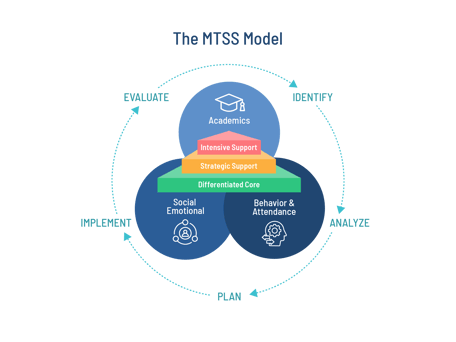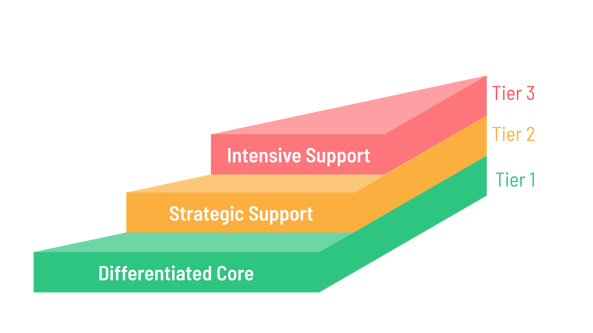We all enjoy the collegial swapping of stories from our early days of teaching and chatting about the teaching memories we have collected over the years. This dialogue of shared experiences is extremely valuable as it can provide some laughs, illustrate how far we have come, and remind us that we are not alone, especially as we continue to learn new skills or take on new initiatives.
As an adjunct university supervisor, I recently found myself reminiscing and “story-swapping” with one of my graduate students and her mentor teacher about the “nuts and bolts” of teaching in secondary settings. My student was assigned to teach algebra for the quarter in an amazing classroom at a Chicago Public High School. Similarly, I had also taught the same age at a transition high school in the city. We discussed the differences in the types of support and intervention we provided to our students before the “gold standard” of MTSS (Multi-Tiered System of Supports) protocols were systemically used as they are in Chicago today.
MTSS wraps around an entire school community and provides academic, behavioral, social-emotional, and attendance support for all students. We recalled that before MTSS, secondary schools were often left “in the dark” regarding supporting their student body. Interventions in the marketplace were often geared towards an elementary audience, and screeners/progress monitors for high schoolers were few and far between. There was minimal support for social-emotional learning (SEL), and attendance was handled separately and not integrated into the “big picture” of students’ overall needs.
Today, we have MTSS, which provides processes for all students' needs to be met. Data are gathered regularly, and collaboration occurs to address academic and non-academic needs, ensuring a holistic approach to support. The marketplace has a plethora of screeners and interventions for secondary use, as well as platforms to collect data and create a full picture of students’ areas of strength and need.
Like all initiatives, there are rewards and challenges when implementing MTSS. Throughout Branching Mind’s work partnering with schools and districts to implement MTSS, we know that mitigating the challenges requires that all schools, regardless of grade levels, engage in thoughtful planning, collaboration, consistency, and resources to ensure a successful implementation. In addition, patience and grace with oneself and colleagues are always needed when acquiring new skills.
Branching Minds collects a running log of questions asked at the beginning stage of our partnership “launching” MTSS in schools. Secondary teachers most often asked the following questions:
“We are high school teachers! Why do we need to implement MTSS? Is this an elementary school initiative?”
"How will I get up to speed on learning to specifically support my student's identified needs?"
"Whoa! I see over 150 students a day! I could really use help understanding how I will create the time to provide more specific support I know my students need, and when am I supposed to collaborate with my colleagues?”
“I teach six periods in a row, and I barely have time to eat a sandwich every single day! How is my schedule going to allow for intervention or support time?”
Why MTSS in Secondary Schools?
 Regardless of grade level, MTSS is essential, full stop. So, when the question, "Why do we need MTSS at the secondary level?" is asked, I feel perplexed because ALL students, regardless of age or grade level, are entitled to the wrap-around support MTSS provides. I usually answer this question with the question, “Why are you not using MTSS?”
Regardless of grade level, MTSS is essential, full stop. So, when the question, "Why do we need MTSS at the secondary level?" is asked, I feel perplexed because ALL students, regardless of age or grade level, are entitled to the wrap-around support MTSS provides. I usually answer this question with the question, “Why are you not using MTSS?”
Now more than ever, after two long years impacted by a worldwide pandemic, we must shift to embrace MTSS in order to meet the academic, social-emotional, attendance, and behavior needs of every single student in our student body. Our students deserve nothing less than this holistic approach.
With So Many Students, How Do We Know Who or Specifically What Needs Support?
 By definition, MTSS relies upon a data-driven approach to determine students’ areas of strength and need. As mentioned earlier, many universal screeners are available today to secondary schools for screening and progress monitoring. Even with large student populations, universal screeners can provide an easy-to-use platform to quickly identify areas of progress and specifics to target for needed support. Screeners are routinely used for academics (recommended three times a year), attendance, SEL, and behavior.
By definition, MTSS relies upon a data-driven approach to determine students’ areas of strength and need. As mentioned earlier, many universal screeners are available today to secondary schools for screening and progress monitoring. Even with large student populations, universal screeners can provide an easy-to-use platform to quickly identify areas of progress and specifics to target for needed support. Screeners are routinely used for academics (recommended three times a year), attendance, SEL, and behavior.
Once areas of strength and need are identified through universal screeners, intervention support can be provided. Student progress is monitored by the data collected and discussed during collaborative meetings. Support should be research-based to ensure efficiency and a proven track record for progress (when matched to the appropriate need). Learn more about the MTSS intervention process with this flowchart.
Resources such as the What Works Clearinghouse provide research-based information to help make the best decisions for which research-based universal screeners, progress monitors, and intervention supports fit the school’s individual needs and budget.
➡️ Related Resource: MTSS in Secondary Schools: Major Challenges, and How to Overcome Them
How Do We Schedule MTSS Collaboration in High Schools?
It is well known that high school teachers teach about 150 (or more) students a day. This factor alone can challenge scheduling any initiative, specifically with planning and executing the intervention and collaboration MTSS requires. As a result, one of the early steps Branching Minds undertakes with secondary schools (and all partners) when implementing MTSS is to complete a deep dive into calendaring. We work to slash all unnecessary meetings and stick to a consistent schedule for collaboration. Once we have revised the meeting lineup, a typical schedule for MTSS collaboration and meetings looks like this:
- All-school meeting: Quarterly meetings to discuss screening data and trends.
- Departmental meetings: Monthly meetings to discuss departmental trends, problem-solve for students not making sufficient progress, and check in on students receiving support at Tier 2 and Tier 3 levels.
- Individual student support meeting: Meetings as needed, providing an individualized deep dive problem-solving for students not making sufficient progress while receiving support at the Tier 3 level.
Check out: 5 Questions to Ensure Efficiency with MTSS Teams & MTSS Meetings
 As our partners redistribute their old required meetings into one of the three new meeting types above, teachers have reported a “lightening” of their meeting load and a new sense of confidence (and gratitude) that collaboration will occur efficiently.
As our partners redistribute their old required meetings into one of the three new meeting types above, teachers have reported a “lightening” of their meeting load and a new sense of confidence (and gratitude) that collaboration will occur efficiently.
In addition, Branching Minds works with schools to ensure that MTSS resources, such as intervention support, are distributed with consideration to need Staff must be provided with time devoted to supporting students receiving support at Tier 2 and Tier 3 levels. Support at each tier looks like this in secondary schools:
- Tier 1: Differentiated general education content.
- Tier 2: Differentiated general education content + small group targeted instruction.
- Tier 3: Differentiated general education content + small group targeted instruction + intensive support.
➡️ Related Resource: Best Practices for Tier 1 For the Secondary Level
What Does Class Scheduling Have To Do With MTSS in Secondary Schools?
Throughout Branching Minds’ partnerships with schools and districts, we have found that restructuring schedules to allow staff to provide MTSS support objectively is a critical component of the transition process. During the schedule restructuring process, we analyze and reconfigure all current courses to allow intervention or support during the day. We consider if classes can be explicitly designed and extended to include time for intervention support. We include utilizing whatever classes are at our disposal, such as homeroom, What-I-Need (WIN) Time, or we create fluid intervention blocks.
 Before you stop reading this blog because just the thought of creating a new schedule to accommodate MTSS is overwhelming, let me first say that, yes, this can be a big undertaking. In addition, at first, our school partners may be wary of “rocking the scheduling boat” as they implement new initiatives. However, the undertaking is always worth it if we have schedules to support every student. The article “The Power of Innovative Scheduling” provides exemplar schedules to share with the staff and can be used as a reminder that “innovative scheduling” will:
Before you stop reading this blog because just the thought of creating a new schedule to accommodate MTSS is overwhelming, let me first say that, yes, this can be a big undertaking. In addition, at first, our school partners may be wary of “rocking the scheduling boat” as they implement new initiatives. However, the undertaking is always worth it if we have schedules to support every student. The article “The Power of Innovative Scheduling” provides exemplar schedules to share with the staff and can be used as a reminder that “innovative scheduling” will:
- Result in the more effective use of time, space, and resources (human as well as material);
- Improve instructional climate;
- Help solve problems related to the delivery of instruction [and intervention and support]; and
- Assist in establishing desired programs and instructional practices (Canaday & Rettig, 1995).
Ensuring all stakeholders have a deep understanding of the reasons for the shift to MTSS to ensure ALL student’s needs are met, there is a more significant opportunity to rally around schedule changes. Providing exemplars of secondary schools that have successfully transitioned to MTSS can also reassure stakeholders that teachers will not be working additional hours but instead targeting instruction and working more efficiently. And, of course, we can return to the powerful question, “Why are we NOT using creative scheduling for MTSS to meet all student’s needs?”
Getting Used to the "New" Can Be Rewarding
As my student teacher, her mentor, and I discussed a few weeks ago, some of the “nuts and bolts” of teaching at the high school level is getting used to the “new,” as challenging as that can sometimes be. So, we agreed to continue our “story-swapping” sessions to bring some levity to lessons we have learned and honor the paths we have traveled. The rewards of getting used to the “new” can be immense, such as targeted student support, taking advantage of the resources that were much harder to come by in the past, and tracking the progress we have achieved.
|
Key takeaways from this article:
|
|
Resources For Using MTSS at the Secondary Level: MTSS in Secondary Schools: Major Challenges, and How to Overcome Them |
Citations
Canaday, R. L., & Rettig, M. D. (n.d.). The power of innovative scheduling. ASCD. Retrieved August 7, 2022, from https://www.ascd.org/el/articles/the-power-of-innovative-scheduling
![[Guest Author] Deanne Rotfeld Levy, M.A.T.-avatar](https://www.branchingminds.com/hs-fs/hubfs/Team/Deanne%2070x70.png?width=82&height=82&name=Deanne%2070x70.png)
About the author
[Guest Author] Deanne Rotfeld Levy, M.A.T.
Deanne Rotfeld Levy is a consultant for Branching Minds regarding MTSS best practices. Deanne is also a University Supervisor at the National College of Education at National Louis University. Deanne previously served as Vice President of Customer Success for Discovery Education and was a Chicago Public Schools special education teacher and case manager. Deanne holds a Master of Arts in Teaching Special Education from National Louis University.

Your MTSS Transformation Starts Here
Enhance your MTSS process. Book a Branching Minds demo today.


















.png?width=716&height=522&name=MTSS-interventions-secondary-school(preview).png)

.png?width=716&height=522&name=Tier%203%20Behavior%20Support%20Planning%20(preview).png)